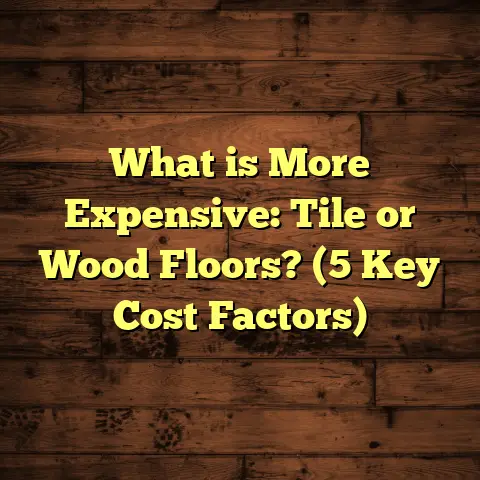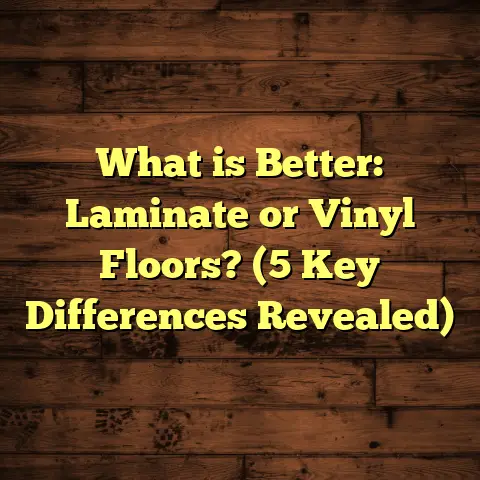What is Floor Accent? (5 Tips to Elevate Your Space!)
I’ve noticed a cool trend popping up in home design lately—people aren’t just picking a flooring type and calling it a day. They’re adding something extra, something that brings personality and flair to their rooms. This “something” is what I call a floor accent. It’s a way to make your space stand out without ripping everything out or breaking the bank.
Floor accents are everywhere now—in magazines, social media posts, and even in high-end design shows. They’ve become a subtle but powerful way to elevate a room’s look and feel. What’s fascinating is how versatile they are. Whether you prefer classic elegance or modern boldness, floor accents can fit your style.
What is Floor Accent?
So, what is floor accent exactly? Simply put, a floor accent is an intentional design element within your flooring that draws attention and adds visual interest. It could be a different material, color, pattern, or texture strategically placed to highlight a certain area or create a unique look.
Think of it as the jewelry on your floor—a border around a room, a patterned inset in the middle, or even a contrasting tile shape. It’s not the whole floor, but a special part that catches your eye and elevates the overall style.
Floor accents can take many forms:
- Borders: A strip of contrasting material running along the edges of a room.
- Inlays: A patterned section set into the middle or focal point of the floor.
- Runners: Long narrow accents that mimic the look of area rugs but are part of the floor.
- Mosaic or Tile Medallions: Decorative shapes created using small tiles or stones.
- Material Mix: Combining hardwood with tile, stone, or vinyl sections for visual contrast.
They’re often used to define spaces in open floor plans, add interest to hallways, or highlight entryways.
Why Floor Accents Matter
When I started installing floors years ago, most clients wanted simple hardwood or carpet. But over time, I noticed more homeowners asking for something unique—something that felt like their own signature on their home.
Floor accents answer that call perfectly. They let you express personality without overwhelming the entire floor. Plus, they can be surprisingly budget-friendly compared to changing an entire flooring system.
There’s also an artistic side to it. I see floor accents as functional art—blending form and function. They bring life to floors that would otherwise be plain and boring.
My Experiences with Floor Accents: Successes and Challenges
Let me share some stories from my work. One of my favorite projects was a living room where the client wanted a rustic vibe but with a modern twist. We used wide plank oak flooring but added a herringbone pattern accent strip around the perimeter. The contrast of the traditional herringbone with the wide planks gave the space a cool edge.
It worked so well that visitors kept asking about it. The client was thrilled. The accent didn’t just add style—it made the room feel custom and intentional.
On the flip side, I had a project where the homeowner requested a bright red tile accent in their kitchen floor to match their retro appliances. Unfortunately, the bold red didn’t complement the muted wall colors and cabinetry as expected. The accent became an eyesore rather than a highlight.
That taught me how important it is to consider the whole room’s color palette when choosing accents.
Another challenge I’ve faced often is installation precision. Floor accents require exact cutting and placement. Even small errors stand out immediately because accents draw attention by design. One time, an accent border was slightly uneven because the installer didn’t use proper spacers—resulting in visible gaps and uneven lines. Fixing it meant redoing a large section.
Why Are Floor Accents Growing in Popularity?
You might wonder why this trend has taken off recently. Here’s what I think:
- Customization Desire: People want homes that feel personal—not cookie-cutter.
- Open Floor Plans: Accents help define zones in open layouts without walls.
- Social Media Influence: Platforms like Instagram inspire homeowners with creative ideas.
- Affordable Upgrade: Compared to full remodels, accents offer big style gains for less money.
- Better Materials & Techniques: Advances in flooring technology make mixing materials easier and more durable.
According to a 2023 survey by Houzz, 54% of homeowners said they were interested in adding unique flooring elements like accents or patterns during renovations.
5 Tips to Elevate Your Space with Floor Accents
If you’re thinking about adding floor accents yourself, here are some tips based on what I’ve learned:
1. Choose Materials That Compliment Each Other
Mixing materials can be fantastic—for example, pairing hardwood with stone or tile accents—but only if their tones and textures work well together.
I once combined warm walnut hardwood with cool gray slate tiles for a foyer accent, and it created a sophisticated look without feeling disconnected.
Data point: According to a survey by Home Design Trends 2023, 62% of homeowners who mixed materials reported higher satisfaction than those who stuck to one.
Wood and tile combos are common because wood offers warmth while tile adds durability in high-traffic spots.
Here are some popular material combos for accents:
- Hardwood + Porcelain Tile
- Engineered Wood + Natural Stone
- Vinyl Plank + Ceramic Tile Insets
- Bamboo + Glass Mosaic Tiles
2. Use Color Wisely
Color can make or break your accent design. Sometimes subtle contrast is better than bold leaps.
In one project, I suggested using slightly darker wood stain for an inset border rather than an entirely different color—it gave depth without overwhelming the space.
Tip: Test samples in your room lighting before committing.
Colors should complement your walls, cabinetry, and furnishings. For example:
- Neutral tones pair well with soft earth colors.
- Dark accents create drama in light rooms.
- Warm tones enhance cozy spaces.
- Cool tones suit modern minimalism.
3. Consider Scale and Pattern
Small patterns suit small spaces; large patterns work better in big rooms. Overly complex designs can confuse the eye and make floors look cluttered.
A client of mine loved geometric shapes, so we created a simple diamond pattern in a hallway runner area using contrasting wood tones. It was striking but clean.
When designing patterns:
- Keep lines clean and shapes balanced.
- Avoid patterns that compete with other decor elements.
- Use repetition for rhythm without chaos.
4. Think About Functionality
Floor accents should add style without compromising durability or safety.
For example, tile insets in high-traffic areas need to be slip-resistant. I’ve seen beautiful glossy tiles cause slips when wet—never fun.
Also consider maintenance:
- Wood needs sealing to protect against stains.
- Tiles with grout require regular cleaning.
- Some materials scratch easily—think about pets or kids.
5. Plan Installation Carefully
Precision matters. If your accent isn’t perfectly aligned or cuts are rough, it ruins the effect.
I always recommend hiring experienced installers for accents because cutting and fitting differ from standard flooring installation.
Poor installation can lead to:
- Uneven surfaces
- Gaps between materials
- Misaligned patterns
In one job I oversaw recently, our installer used laser-guided tools for perfect alignment on an intricate parquet accent border—it made all the difference.
What Data and Research Say About Floor Accents
I dug into some research to see how floor accents impact home value and buyer appeal.
- A 2022 National Home Improvement Survey found that homes with custom flooring details like accents saw an average resale increase of 3-5% compared to those with plain floors.
- Another study by Flooring Today showed that 48% of buyers said unique flooring features influenced their purchase decision positively.
These stats back up what I’ve seen firsthand: floor accents don’t just look good; they add real value.
Additionally:
- According to Zillow data from 2023, kitchens with decorative tile insets saw an average price lift of $8,000 on sale compared to those without.
- The National Association of Realtors reports that well-designed wood flooring increases buyer interest by 22%.
More Insights From My Work
I keep track of my projects’ outcomes to learn what works best. Here’s what I noticed:
- Material combos: Hardwood plus tile or stone accents remain most popular.
- Patterns: Borders and runners are preferred over large central patterns for flexibility.
- Colors: Neutral tones with subtle contrast win over bright colors.
- Maintenance: Accents made from durable materials fare better long term.
One interesting case was a client who installed recycled glass tile accents in their kitchen floor. Not only did it look stunning, but they also reported the tiles were easy to clean and held up well under heavy use.
Common Challenges With Floor Accents
They’re not always smooth sailing though. Here are some problems I’ve faced:
- Mismatch with room style: An accent that doesn’t fit room decor feels out of place.
- Installation errors: Misaligned patterns or uneven height between materials.
- Cost overruns: Custom accents can increase price by 15–30%.
- Wear and tear: Some materials show scratches or stains more easily.
- Cleaning difficulties: Intricate grout lines or textured tiles can trap dirt.
To avoid these pitfalls, good planning and working with pros makes all the difference.
How to Choose the Right Floor Accent for Your Home?
Choosing your floor accent depends on:
- Your home’s style
- The room’s function
- Your budget
- Maintenance preferences
Match Your Home Style
For traditional homes: wood borders or parquet designs work well.
Modern homes: geometric tile insets or mixed-material strips add sleekness.
Rustic cabins: natural stone or distressed wood accents enhance charm.
Eclectic spaces: colorful mosaics or patterned vinyl planks create fun focal points.
Room Function Matters
Kitchens & bathrooms: tile or stone accents suit water-prone areas.
Living rooms & dining rooms: wood-patterned borders look elegant.
Entryways & hallways: durable mixed-material runners handle traffic.
Bedrooms: subtle tone-on-tone wood designs maintain warmth without distraction.
Budget Considerations
Floor accents can range from affordable vinyl strips to expensive marble medallions.
On average:
| Accent Type | Typical Cost per sq ft* |
|---|---|
| Vinyl/laminate strips | $3 – $7 |
| Hardwood borders | $8 – $15 |
| Ceramic/porcelain tile | $10 – $20 |
| Stone mosaic inserts | $20 – $40 |
*Includes materials & labor; varies by location
Planning your budget early helps you select options without surprises.
Maintenance Preferences
If you want low maintenance:
- Choose durable materials like porcelain tile or luxury vinyl.
If you don’t mind upkeep:
- Wood accents require refinishing over time.
Textured tiles may need frequent cleaning but add character.
Step-by-Step Guide to Installing Floor Accents
If you’re considering DIY or want to understand the process before hiring pros:
- Plan Your Design
Sketch your accent layout considering room dimensions and focal points.
- Choose Materials
Order samples and test them in your space’s lighting conditions.
- Prepare Subfloor
Ensure surface is level and clean before installation begins.
- Cut Materials Precisely
Use proper tools—especially for wood inlays or tile mosaics—to get clean edges.
- Install Base Flooring
Lay main floor material around planned accent areas first if needed.
- Place Accent Pieces
Set accent pieces carefully with spacers for grout lines if applicable.
- Grout & Seal
For tiles, grout lines need filling; wood may need sealing after installation.
- Allow Curing Time
Wait recommended time before heavy use to ensure durability.
- Final Inspection
Check alignments, smoothness, and finish quality; fix any issues immediately.
Personal Story: How Floor Accents Saved My Client’s Living Room Design
A few years ago, I worked with a couple renovating their dated living room. They initially planned simple oak floors but weren’t sure if it would feel too plain next to their colorful furniture and art collection.
After discussing options, we added an ebony-stained wood border around the perimeter with occasional inset medallions near seating areas shaped like leaves—matching their nature-themed decor subtly but beautifully.
The result was stunning—the border framed the space nicely and pulled together mismatched colors into harmony without overpowering them. The couple loved how much character this simple addition gave their room—and it cost less than replacing all furniture!
How Floor Accents Can Define Open Spaces
Open concept homes offer flexibility but also challenges in defining separate zones visually without walls.
Floor accents are perfect here—they create invisible “lines” that signal transitions between kitchen/dining/living areas while maintaining openness.
For example:
- A tile inset under dining table area within hardwood flooring
- Runner borders marking hallways
- Different plank directions alternating between zones
This technique helps avoid blandness and guides flow naturally through large rooms.
Popular Accent Styles by Region (Based on My Projects)
From my experiences across different regions:
- In coastal areas, light-colored woods paired with sea glass mosaic tiles reflect beach vibes.
- In mountain cabins, rough-hewn stone insets with deep cherry wood borders are common.
- Urban apartments lean towards sleek geometric tile accents mixed with engineered wood floors.
- Southern homes often favor warm-toned hardwoods with classic parquet patterns as accents.
Each region’s climate and culture influence choices—and it’s fun adjusting designs accordingly!
How Technology Has Improved Floor Accent Design & Installation
Technology plays a huge role now:
- Computerized design software lets clients see mockups before choosing materials.
- Laser-cutting tools improve precision dramatically for custom shapes/inlays.
- Waterjet cutting enables intricate stone/tile designs impossible by hand.
- Mobile apps help measure spaces accurately for better estimates (like FloorTally).
These advances reduce errors and waste while expanding creative possibilities for accents that fit perfectly every time.
Environmental Benefits of Using Floor Accents
An often overlooked aspect: incorporating recycled or eco-friendly materials as accents can reduce environmental impact without sacrificing style.
Examples include:
- Recycled glass tile mosaics
- Bamboo strips mixed with hardwood
- Cork inserts for softness and sustainability
I had one client eager to use reclaimed barn wood as an accent strip in their hardwood living room floors—giving old material new life while creating meaningful texture and story underfoot.
What’s Next for Floor Accents?
Trends keep evolving:
- Expect more mixed-material floors combining vinyl planks with natural elements for durability + beauty.
- Smart floors integrating LED strips as accents are emerging—imagine mood lighting embedded right into your borders!
- Customizable modular accents let homeowners swap designs seasonally without replacing whole floors.
These innovations will keep floor accents fresh and exciting long into the future.
If you’re thinking about adding an accent to your floors but unsure where to start—you’re not alone! It’s a creative project but requires thoughtful planning for best results.
What styles catch your eye? Do you prefer subtle borders or bold centerpiece patterns? Are you leaning towards wood, tile, stone—or maybe mixing them?
Feel free to ask me any questions! I love helping people bring their flooring ideas to life because it’s one of those home improvements that combines beauty with lasting impact every day you walk across it.





